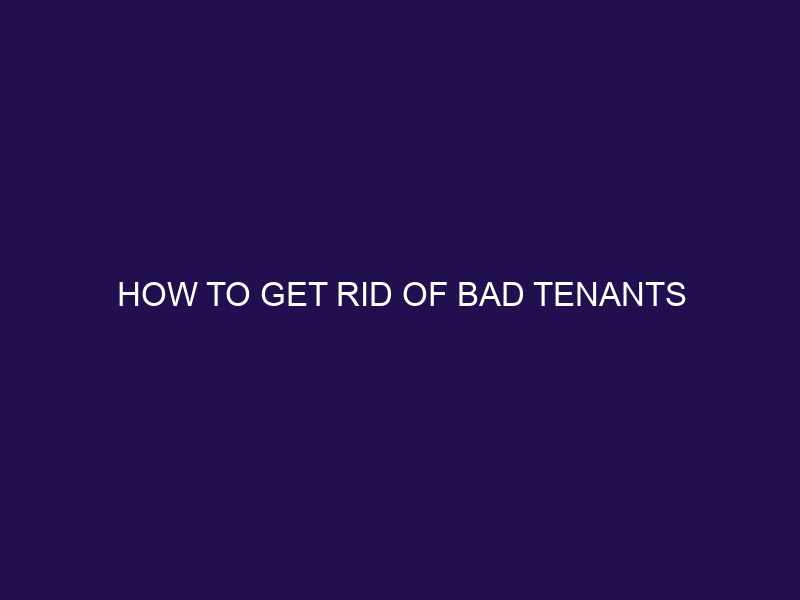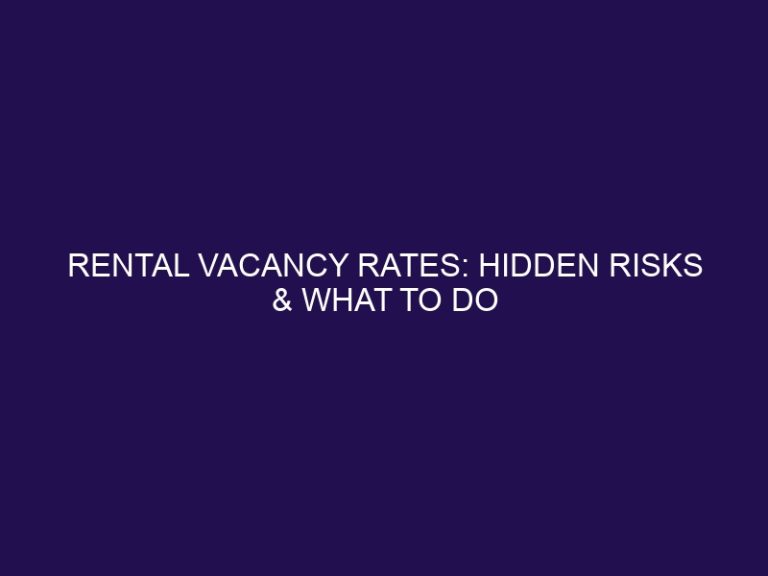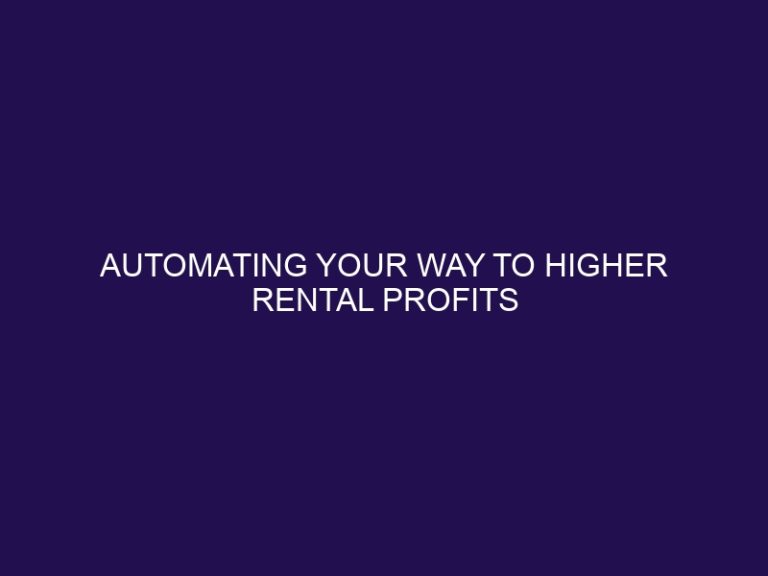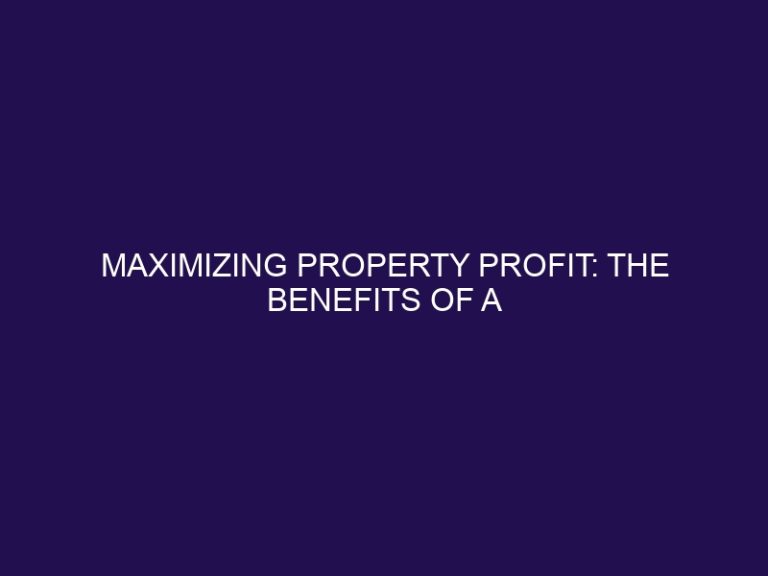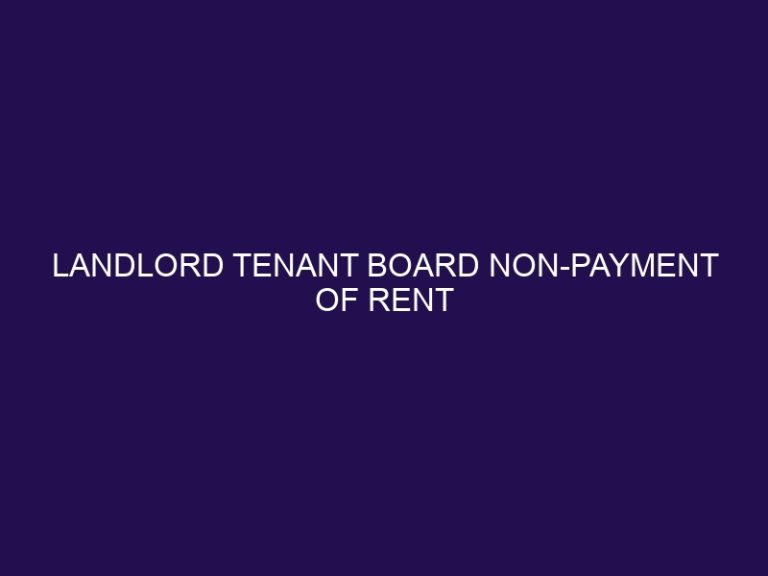How to Get Rid of Bad Tenants
Getting stuck with bad tenants can be a nightmare for landlords and property owners. Dealing with tenants who are disruptive, non-compliant, or simply refuse to pay rent can cause significant stress and financial loss. However, there are steps you can take to get rid of bad tenants and protect your property. This article will provide a comprehensive guide on how to handle bad tenants effectively. It will cover topics such as identifying bad tenants, screening and selecting tenants, dealing with inherited bad tenants, steps to take to get rid of them, legal considerations, and resources for landlords. It will offer tips on preventing future bad tenants by improving the tenant screening process and enhancing property management practices. By following these guidelines, you can navigate the challenges of dealing with bad tenants and ensure a smoother and more profitable rental experience.
Identifying Bad Tenants
Identifying bad tenants is crucial for landlords in order to avoid potential problems and safeguard their property. Here are some crucial factors to consider when identifying bad tenants:
- Incomplete or False Application Information: It’s important to carefully examine the application for any inconsistencies, missing details, or unreliable references.
- Poor Rental Check for any previous evictions, late payments, or damage to rental units.
- Unstable Employment: A stable income and employment history are strong indicators of a responsible tenant.
- Unwillingness to Sign a Lease: It is advisable to steer clear of tenants who resist signing legal agreements.
- Bad Communication: Lack of responsiveness, rude behavior, or frequent complaints should be seen as red flags.
As a cautionary tale, one landlord made the mistake of renting to a tenant who consistently paid rent late and caused damage to the property, resulting in costly repairs. This experience emphasized the importance of conducting thorough tenant screening to avoid such issues in the future.
What are the Signs of a Bad Tenant?
What are the Signs of a Bad Tenant?
Identifying a bad tenant is crucial for landlords to ensure the smooth management of their properties. Here are some signs to look out for when screening potential tenants:
Inconsistent rental history or frequent changes in residences
Poor credit history or previous evictions
Unwillingness to provide references or incomplete application forms
Frequent late or missed rent payments
Constant complaints from neighbors about noise or disturbances
Poor communication or unresponsiveness
Unauthorized pets or additional occupants
Signs of property damage or neglect during showings
By carefully observing these signs and conducting thorough tenant screenings, landlords can avoid the hassle and costs associated with problematic tenants.
How to Screen and Select Tenants?
- Wondering how to effectively screen and select tenants? Follow these steps:
- Start by requiring a completed rental application form that includes personal information, employment history, and references.
- Perform thorough background checks and credit checks to verify the tenant’s financial stability and history.
- Contact previous landlords to gather information about the tenant’s rental history, including payment punctuality and property upkeep.
- Conduct interviews with potential tenants to assess their personality, communication skills, and compatibility with existing tenants.
- Don’t forget to verify income and employment information to ensure the tenant can afford the rent.
- Consider using a scoring system or criteria checklist to objectively evaluate each applicant.
- Lastly, make sure to follow fair housing laws and avoid any discriminatory practices during the selection process.
By following these steps, landlords can minimize the risks associated with bad tenants and select responsible, reliable, and respectful individuals for their rental property.
What to Do if You Inherit Bad Tenants?
If you inherit bad tenants when taking over a property, it’s crucial to know what to do if you inherit bad tenants. Handling the situation carefully and legally is of utmost importance. Here are the recommended steps you can take:
- Review the lease agreement to fully understand the terms and conditions when dealing with bad tenants.
- Document any lease violations or issues you observe with the tenants inherited from the previous owner.
- Send a written notice to the tenants, clearly outlining the lease violations that need immediate attention and requesting corrective action.
- Communicate with the tenants and make sure to document all conversations to keep a thorough record of the interactions with these individuals.
- If the issues persist, it’s necessary to issue an eviction notice following the proper legal procedures for dealing with bad tenants.
- File for an eviction with the appropriate court if the tenants fail to comply with the eviction notice after having been given sufficient time to rectify their actions.
Steps to Get Rid of Bad Tenants
Discover the necessary steps to successfully navigate the challenging process of dealing with troublesome tenants. From reviewing the lease agreement to filing for an eviction, this section will provide you with a comprehensive guide on how to handle the situation effectively. Learn how to document lease violations, initiate crucial conversations, and ultimately take the necessary legal actions to protect your property. It’s time to regain control and ensure a peaceful environment for both tenants and landlords.
Step 1: Review the Lease Agreement
To effectively handle bad tenants, Step 1 is to thoroughly review the lease agreement. This includes understanding the terms and conditions, such as the duration of the lease, rent payment details, and clauses regarding tenant behavior and responsibilities. By familiarizing yourself with the lease agreement, you can identify any violations or breaches committed by the tenant and take appropriate actions. It is crucial to have a clear understanding of your rights and obligations as a landlord before proceeding with any further steps.
A landlord once discovered that a tenant had been subletting the property without permission, which was a clear violation of the lease agreement. By Step 1, reviewing the lease agreement, the landlord was able to address the issue promptly and evict the unauthorized tenant, ensuring the integrity of the property and the rights of all parties involved.
Step 2: Document Lease Violations
- Step 2: Document Lease Violations: It is crucial to document lease violations when dealing with bad tenants. Here are the steps to follow:
- Gather evidence: Collect all relevant documents, such as the lease agreement and communication records, to support your case.
- Document the violations: Keep a detailed record of each violation, including dates, times, and descriptions of the incidents.
- Take photographs or videos: If there is physical damage to the property, document it visually to strengthen your case.
- Notify the tenant: Inform the tenant in writing about the lease violations and provide them with a chance to rectify the situation.
- Keep copies: Make copies of all documents related to the lease violations, including letters, notices, and any correspondence with the tenant.
By documenting lease violations, you have a solid foundation when taking legal action or pursuing eviction. Remember to consult with a lawyer if needed to ensure you follow the correct legal procedures in your jurisdiction.
Step 3: Send Notice of Lease Violation
- Review the lease agreement to understand the specific terms that have been violated.
- Document the lease violations with evidence such as photographs, witness statements, or communication records.
- Send Notice of Lease Violation: Compose a written notice clearly stating the violations and demanding compliance within a specific timeframe.
- Send the notice to the tenant via certified mail or personally serve it, ensuring proof of delivery.
- Keep a record of all communication and interactions with the tenant regarding the lease violation.
- If the tenant fails to rectify the violations within the specified timeframe, proceed with the next steps to initiate the eviction process.
In a similar situation, a landlord sent a notice of lease violation to a tenant who consistently disrupted the peace with loud parties. After receiving the notice, the tenant rectified the behavior, avoiding eviction and fostering a more harmonious living environment with the other tenants.
Step 4: Communicate and Document Conversations
To effectively handle bad tenants, it is crucial to communicate and document conversations appropriately. Here are the essential steps to follow:
- Open Dialogue: Initiate a conversation with the tenant about their lease violations or problematic behavior.
- Be Clear and Firm: Clearly articulate the issues and expectations, emphasizing the consequences if the behavior continues.
- Document Everything: Accurately record the details of the conversation, including dates, times, participants, and key points discussed.
- Communicate and Document Conversations: Follow up oral conversations with written communication, such as an email or a letter, to reinforce the seriousness of the matter.
- Keep Copies: Maintain copies of all written communication sent to the tenant for future reference.
- Request Confirmation: If the tenant responds to written communication, request acknowledgement or confirmation of receipt.
In one instance, during a conversation with a difficult tenant, they expressed concerns about the property’s maintenance. I addressed their concerns promptly, discussed a plan for repairs, and documented our conversation for reference. This open communication helped resolve the issue and maintain a positive landlord-tenant relationship.
Step 5: Issue an Eviction Notice
- Review the lease agreement to ensure that the tenant has violated the terms.
- Document the lease violations with supporting evidence, such as photographs or witness statements.
- Send a notice of lease violation to the tenant, clearly stating the issue and the required actions to be taken.
- Communicate with the tenant and document all conversations, including dates, times, and content discussed.
- Step 5: Issue an Eviction Notice if the tenant fails to comply with the lease terms or resolve the issues.
- File for an eviction through the appropriate legal channels, adhering to local laws and procedures.
Fact: In the United States, eviction laws vary from state to state, so it’s important to familiarize yourself with the specific regulations in your area.
Step 6: File for an Eviction
Filing for an eviction: A Detailed Guide
Filing for an eviction is the final step in getting rid of bad tenants. If you find yourself in such a situation, here is a step-by-step process to follow:
- Review the lease agreement to ensure that the tenant has violated the terms.
- Document lease violations with evidence such as photographs, written complaints, or witnesses.
- Send a notice of lease violation to the tenant, clearly stating the breach and giving them a specific time to rectify the situation.
- Communicate and document conversations with the tenant regarding the violations and their intentions to comply.
- Issue an eviction notice if the tenant fails to rectify the violation within the given timeframe.
- Now, it’s time to take the next step: file for an eviction with the appropriate court. Ensure you follow all the required legal procedures and provide the necessary documentation.
By diligently following these steps, landlords can effectively navigate the eviction process, ensuring it is both efficient and in compliance with the law.
Legal Considerations and Resources
As you navigate the process of dealing with problematic tenants, understanding the legal aspects is crucial. In this section, we’ll dive into the world of legal considerations and resources to help you navigate landlord-tenant laws. From gaining clarity on the intricacies of these laws to seeking guidance from attorneys, we’ll explore the valuable insights and resources available to landlords. So, let’s delve into this essential aspect that can empower you as a landlord and protect your rights.
Understanding Landlord-Tenant Laws
Understanding landlord-tenant laws is essential for landlords to safeguard their rights and facilitate a seamless rental process. Key considerations involve familiarizing yourself with local laws and regulations pertaining to rental agreements, eviction procedures, security deposits, and tenant rights. It is crucial to comprehend the legal requirements for lease agreements, including the necessary information and clauses that are prohibited. Additionally, staying updated on eviction procedures and timelines, which entail providing proper notice and adhering to due process, is imperative. To ensure compliance and prevent legal complications, it is essential to remain well-informed about any changes in landlord-tenant laws. Seeking guidance from legal professionals or accessing resources specific to landlord-tenant laws in your area can provide further clarity and assistance.
Consulting an Attorney
During a challenging situation with a troublesome tenant, a landlord made the decision to consult an attorney for assistance. Consulting an attorney is crucial when dealing with bad tenants. The attorney carefully reviewed the lease agreement, identified the tenant’s violations, and offered guidance to the landlord on sending proper notices. They effectively communicated and documented conversations and provided expert guidance throughout the eviction process. Consulting an attorney who specializes in real estate and landlord-tenant law is essential for landlords to protect their rights and interests. With the attorney’s expertise and knowledge of landlord-tenant laws, the landlord successfully resolved the issue and learned the importance of consulting legal professionals when dealing with difficult tenants.
Resources for Landlords
Useful Resources for Landlords
Preventing Future Bad Tenants
Tired of dealing with troublesome tenants? Say goodbye to future headaches with our expert tips in preventing bad tenants. Discover how to enhance your tenant screening process and implement top-notch property management practices. No more sleepless nights worrying about late payments or property damage. We’ve got you covered with practical strategies to ensure hassle-free tenancies. Get ready to transform your rental property into a haven for responsible and reliable tenants.
Improving Tenant Screening Process
- Improving the tenant screening process is crucial for landlords to avoid dealing with bad tenants. Here are some steps to enhance the screening process:
- Background Checks: Conduct thorough background checks, including criminal history, credit history, and previous rental references.
- Income Verification: Verify the prospective tenant’s income to ensure they can afford the rent.
- Reference Checks: Contact previous landlords to gather insights about the tenant’s behavior, payment history, and overall reliability.
- Interview Applicants: Have a face-to-face or phone interview to assess their compatibility and gauge their level of responsibility.
- Collect Application Fees: Charging an application fee encourages serious applicants and helps cover the costs of screening processes.
By implementing these steps, landlords can significantly reduce the likelihood of renting to bad tenants and create a more secure rental environment.
Enhancing Property Management Practices
Enhancing Property Management Practices is paramount when it comes to averting future problems with tenants. To achieve this, landlords should follow a few crucial steps:
- Improving the tenant screening process is vital. This involves conducting comprehensive background checks, verifying income and employment details, and reaching out to previous landlords for references.
- Establishing clear tenant expectations is key. It is important to openly communicate lease terms, rules, and regulations to tenants right from the start.
- Regular property inspections should be conducted to identify and promptly address any maintenance or lease violations.
- Effective communication is essential. Landlords need to keep lines of communication open with tenants and promptly address any concerns or issues that may arise.
- Prompt maintenance and repairs are crucial. Landlords should respond swiftly to tenant maintenance requests to ensure the property is well-maintained.
- Implementing tenant retention strategies can be beneficial. This involves creating a positive living environment and offering incentives to encourage good tenants to renew their leases.
By implementing these practices, landlords can minimize the risk of encountering bad tenants and maintain a harmonious landlord-tenant relationship.
Frequently Asked Questions
How can landlords deal with tenants who engage in illegal activities?
Landlords can prevent illegal activities by screening applicants for criminal history, conducting regular inspections to identify signs of illegal activity, and promptly reporting any suspicions or evidence to the appropriate authorities.
What are some preventative steps landlords can take to avoid property damage caused by unruly tenants?
Landlords should have a well-written lease that clearly outlines maintenance expectations, conduct a detailed move-in inspection, and perform routine inspections to address any maintenance concerns. They should also communicate with tenants about the importance of taking care of the property and promptly address any maintenance issues that arise.
What should landlords do if tenants consistently pay rent late?
Landlords should have rigid policies in the lease regarding rent payments and consequences for late payment. They can consider using automated rent reminders to encourage timely payments. It is crucial to treat all tenants equally and follow the appropriate legal process if rent is consistently late.
Can landlords use sneaky ways to remove bad tenants?
No, landlords cannot use sneaky or illegal methods to remove tenants. Self-help evictions, such as changing locks or turning off utilities, are illegal and can result in criminal charges. The only legal way to remove tenants is by filing for eviction in court.
How can landlords effectively screen applicants to avoid tenant problems?
Landlords should conduct thorough tenant screening, including credit checks, criminal background checks, eviction reports, income verification, character references, and rental history verification. This comprehensive screening process can help identify potential problem tenants and reduce the risk of future issues.
Can landlords provide flexible reasons for not renewing a tenant’s lease?
In some jurisdictions, landlords may need to provide a justification for non-renewal. While some jurisdictions allow landlords to choose not to renew a tenant’s lease without offering specific reasons, it is essential to follow the legal requirements and communicate why the lease is not being renewed through a polite notice within the specified time window.

